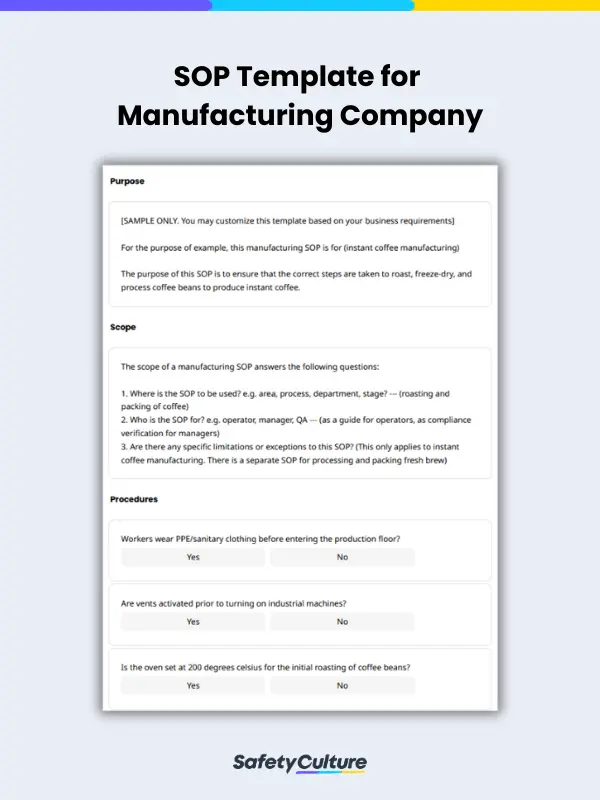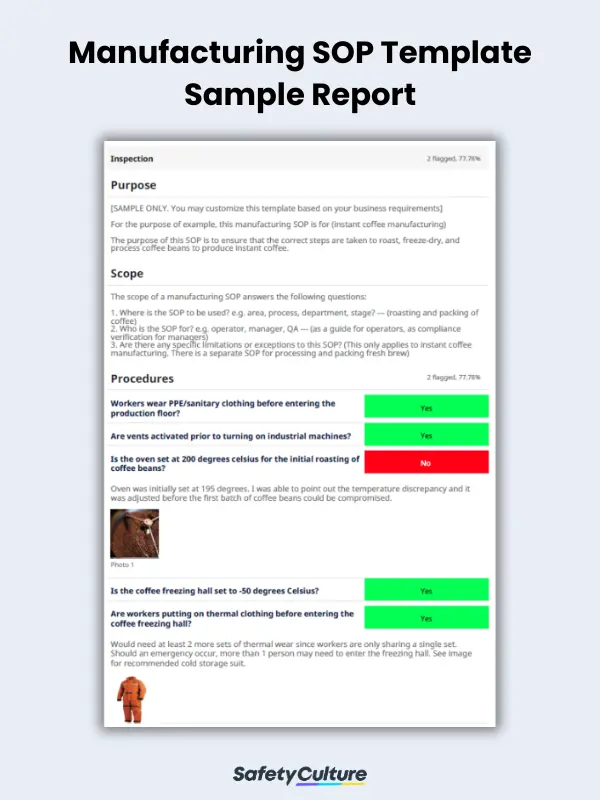What is a Manufacturing SOP?
A manufacturing SOP (Standard Operating Procedure) is a set of documented step-by-step work instructions designed to guide workers in performing manufacturing tasks. Manufacturing SOPs helps promote work consistency, prevent loss of quality, and retain brand reputation.
Consequences of Noncompliance With Manufacturing SOPs
A good manufacturing SOP is designed to streamline the production process while minimizing the risk of errors. Noncompliance with manufacturing SOPs could result in the following consequences:
- Lack of quality control
Manufacturing SOPs help produce high-quality products consistently. Failure to comply with manufacturing SOPs may result in inconsistent quality outcomes and unsatisfied clients. - Low productivity
Manufacturing SOPs are designed to improve efficiency. Noncompliance makes it difficult to achieve maximum productivity since operational time frames will vary for each worker. - Subjective performance evaluations
SOPs clearly define worker tasks and responsibilities. Objective performance evaluations are done by measuring actual performance against the standard set by manufacturing SOPs. If management and workers don’t follow the same standard, expectations become unclear and evaluations may be influenced by personal biases. - Communication breakdown
SOPs communicate process updates to workers. If workers fail to comply with SOPs, they risk making errors that could compromise the quality and efficiency of their work. - Increased risk of accidents
Safe work practices are often integrated into manufacturing SOPs. Noncompliance may put workers at a higher risk of work-related accidents or injuries.
How to Write a Manufacturing SOP
Complying with regulations and producing consistent outputs don’t have to be an arduous journey. Preparing a well-written manufacturing SOP document can guide employees to perform routine tasks in the best and safest way possible. There is no official standard in writing an SOP document. However, some steps can help in writing an effective SOP.
Step 1: Determine the goal
Writing your manufacturing SOP begins with thinking of what you want to accomplish. Whether starting a new process or improving an existing one, determining the end game or the goal makes it easier to write the SOP document.
To give you an idea, we’ve written down the following examples:
|
Manufacturing SOP Compliance Template | Example 1: |
| Purpose: The purpose of this SOP is to ensure that the correct steps are taken to roast, freeze-dry, and process coffee beans to produce instant coffee. |
|
Tablet Compression SOP Checklist | Example 2: |
| Purpose: The purpose of this SOP is to ensure that the correct steps are taken when using the tablet press to perform tablet compression. |
Step 2: Define the scope
The scope defines the extent of your SOP document. It clarifies details such as limitations or exceptions of the SOP, and the people who will be engaging with it or will be impacted.
|
Manufacturing SOP Compliance Template | Example 1: |
||
| Scope: | – Where is the SOP to be used?
Chemical Manufacturing Lab – Who is the SOP for? Lab Personnel and Tablet Press Operators – Are there any specific limitations or exceptions to this SOP? This only applies to the production of pharmaceutical tablets. |
|
|
Tablet Compression SOP Checklist | Example 2: |
||
| Scope: | – Where is the SOP to be used?
Chemical Manufacturing Lab – Who is the SOP for? Lab Personnel and Tablet Press Operators – Are there any specific limitations or exceptions to this SOP? This only applies to the production of pharmaceutical tablets. |
|
Step 3: Choose a format
There are various formats you can write an SOP document. A manufacturing SOP commonly uses a step-by-step format, which is straightforward and easy to follow. There’s also the hierarchical format which is similar to the prior, the only difference is that it provides more detailed and specific instruction for each step. Lastly, the flowchart format where processes are illustrated. This is most suitable for processes that require decision-making. You can choose to use one or combine them, so long as it’s appropriate and can be easily understood by your audience.
Step 4: Write down the procedures
Depending on the format you chose, start writing down the procedures of your SOPs focus. A good principle to follow when writing is the 5 C’s: clear, concise, correct, courteous, and complete. Doing so will help eliminate the guesswork from the procedure and ensure that each step performed is consistent.
|
Manufacturing SOP Compliance Template | Example 1: |
||
| Procedure: | Step 1 – Wear PPE or sanitary clothing before entering the production floor
Step 2 – Activate vents before turning on industrial machines Step 3 – Set oven to 200°C for initial roasting of coffee beans Step 4 – Set coffee freezing hall to -50°C Step 5 – Put on thermal clothing before entering coffee freezing hall Step 6 – Set low pressure vacuum at 60°C Step 7 – Check conformity to specs and for visual defects during assembly line production Step 8 – Perform final inspections before products are packed in boxes |
|
|
Tablet Compression SOP Checklist | Example 2: |
||
| Procedure: |
|
|
Preview the full manufacturing standard operating procedure sample PDF report.
Step 5: Review and update where necessary
After writing your SOP document, review and test it with other team members before sending it to stakeholders for approval. Once it gets approved, it will then be implemented and shared across relevant employees. However, it doesn’t stop there. SOPs should be continuously reviewed and updated, preferably every 6-12 months or as necessary.
Manufacturing SOP Example
For reference, here’s a completed example of SOP in manufacturing using a template:
Manufacturing SOP FAQs
In an ideal scenario, a manufacturing company would have a dedicated team for creating their SOPs. But in reality, one person–typically the process engineer–takes this job. To ensure a clear, concise, and accurate SOP, the writer should consult the employees working on the ground, their supervisors, and safety officers.
SOPs in manufacturing come in two types: technical and management SOPs. A technical SOP shows workers how to carry out and complete specific tasks through work orders and inspections. On the other hand, a management SOP lays down the steps in defining, implementing, and documenting all other forms of SOPs in the company.
Depending on the purpose and depth of the plan, manufacturing SOPs may come in the following forms:
- Hierarchical steps – indicate multiple steps for complex processes
- Flowcharts – map out action items for several potential results
- Checklists – lays out a step-by-step guide on completing specific tasks




